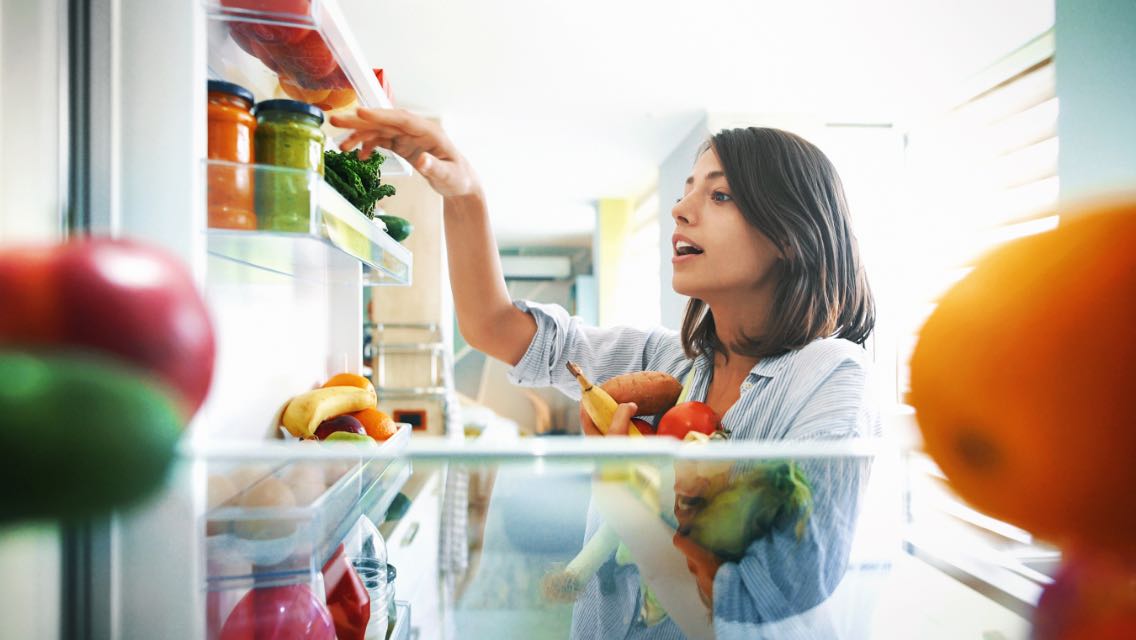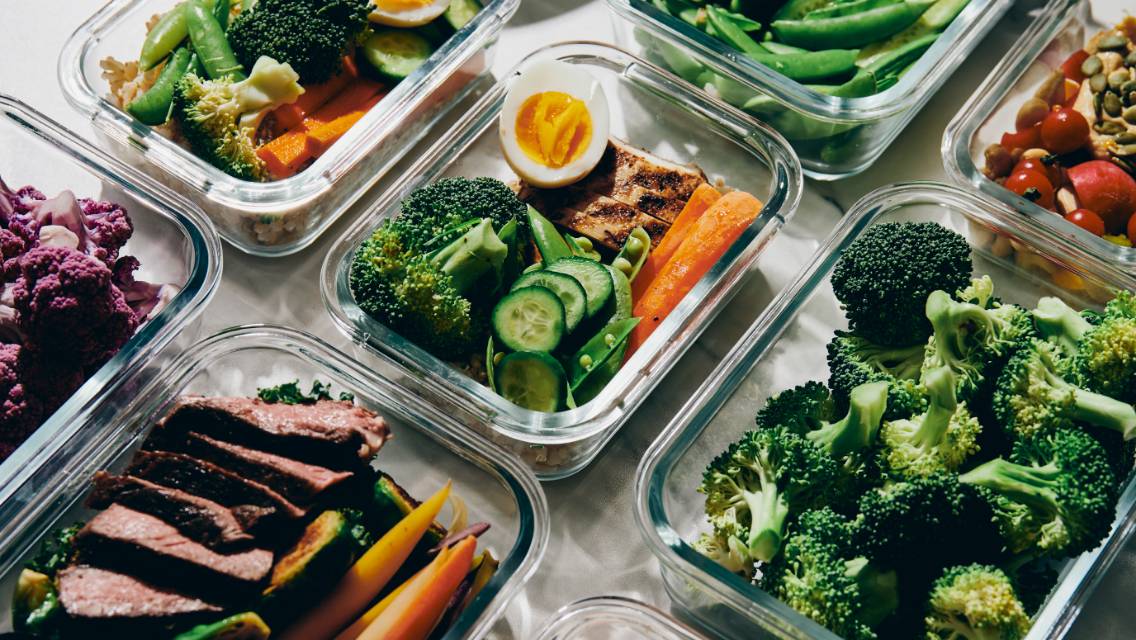Here’s the thing: We all have great intentions. But when it comes to eating healthy and filling our refrigerators with the best foods, I’ve seen my clients make some common mistakes over the years.
Most often, we use those good intentions and motivations to stock the fridge full of all sorts of healthy foods and more than enough vegetables and fruits. But then it all goes bad before we even get to use it.
One of my favorite things to do with my clients is to help them clean out their kitchens and refrigerators. That means trashing all of the things that didn’t align with their healthy-living goals and teaching them tricks for organizing all of it. Plus, I help them choose the right foods based on their goals and preferences to stock it.
Your refrigerator needs to match your meal-planning strategies. Otherwise, even with the best intentions, you end up tossing away all of the healthy (and spendy) foods that you didn’t use in time (or couldn’t easily find), creating feelings of defeat.
If you are looking for ways to organize and set up your fridge so that it’s easier for you to stick to your healthy-eating plan, this guide is for you.
If you have great intentions, but constantly feel like you are throwing away good food because it goes bad, this guide is also for you.
And if you aren’t that motivated just yet, but want basic tips on what foods to prioritize in your fridge — and where they should go — this guide is also for you.
First Things First
When it comes to coaching clients, I start every program with a battery of assessments — lab testing, movement screens, nutrition, food journal, etc. — because I want to know as much as I can about them.
When it comes to their refrigerator, I tell them to open up the door and take a good hard look. How do you feel when you look in there? Does it feel full and overwhelming? Overstuffed?
In my opinion, the inside of your fridge should feel fresh, clean, and appropriately filled with appealing and easy-to-grab healthy foods. If you look in there and feel like you can’t find anything to eat, that’s not optimal. It should always feel like it’s full of plenty of options, while matching your current meal prep and eating strategies.
You also don’t want it to feel overstuffed. Besides being difficult to find things, it’s harder for cool air to circulate, which helps keep your food fresh, when everything is jammed in there. Try to keep plenty of breathing room in between foods or consider going shopping more frequently (with smaller grocery runs).
Next, and before we get to cleaning, it’s a good time to check your fridge’s temperature. The ideal temperature is 40 degrees F (5 degrees C) or below. Anything warmer than that increases the risk of growing harmful food bacteria. And if it’s too cold, some foods might freeze.
Clean It Out
Here’s the fun part: Get rid of the stuff that’s expired. Condiments or the side door is usually the first place I start.
At the same time, get rid of any clutter. If you have a ton of individual ketchup packets (from restaurants) or two of anything (I recently had three mustard containers), throw them out.
If you’ve got leftovers, either love them or leave them. If you constantly find yourself throwing them away because they don’t sound appealing the next day, you might need to modify recipes to make smaller amounts at a time.
Also, let go of those foods that “sounded” like a good idea, but you haven’t embraced. Even if they haven’t expired yet, ask yourself, Do I think I’ll be eating or using this? Right now, I’m thinking personally about a giant value-sized jar of sauerkraut that I bought last year and probably haven’t opened in over eight to 10 months.
If you want to adopt some healthy changes, this is also a good time to get rid of any foods you tend to overeat or that may get in the way of your current health goals. For many of my clients, this might include bottles of wine (consider storing in your garage or basement fridge if you have one so they aren’t right in your face every day) and/or leftover cake or dessert (pitch it or move it).
Consider your fridge as your place for daily foods. Any item that you wouldn’t be eating regularly doesn’t need to be in there.
Next, take out foods that you don’t necessarily need. I often find a lot of produce taking up space (avocados, potatoes, apples, oranges, etc.).
I always remind my clients: If you buy something in a grocery store that isn’t refrigerated, you don’t need to refrigerate it at home. Keep a wire basket or a nice bowl on your counter for those foods. It will free up needed space in the fridge but also remind you that they’re there. Having that bowl out reminds me to use up those precious avocados and encourages me (and my family) that certain fruits can be the most portable and convenient snacks.
Lastly, if it’s been a while, clean all the shelves and doors. Since it’s the fridge, you definitely don’t want to use any harmful cleaners. I tend to use a combination of warm water, vinegar, and a little lemon or orange essential oil (to make it smell fresh) to get the crud out and off.
Up Your Organization Game
My clients know I’m a huge fan of clear, glass containers. Glass is not only a better and safer way to store and heat foods (in comparison to plastic), but it also makes leftovers or prepped meals look more appealing. And it’s really easy to see what’s in them.
If you don’t have any, consider investing in some glass containers. I prefer white lids because it looks cleaner. And avoid the ones that have patterns and make it harder to see what food is inside.
You might also consider clear bins or baskets for your fridge if you have a lot of prepackaged foods for little hands (e.g., cheese sticks or single-serving Greek yogurt containers) that make it easy to grab but also to stay organized.
If you keep a couple of containers of milk or creamer up top, you could also use containers to make it look more streamlined and clean. You can also find specific containers that can hold sparkling water cans or water bottles if you like to keep those as go-tos for daily use.
How to Line it Up
Once we’ve assessed, cleaned it out, and gathered all the proper tools to help us organize, it’s time to put the food in the right places to make it easy to consume. We break a few usual rules (existing habits) so stay with me. How I stack up the fridge has helped me for years and has done wonders for my clients.
Top Shelf
I reserve the very top shelf for anything that is in a beverage state, including any milk or milk alternatives, my pitcher of filtered water, iced coffee, coffee creamer, and cans of sparkling water.
Because it’s at eye level, I never put anything super appealing that would make me crave a snack (e.g., a half-opened bottle of wine). I like to stock up on all of these things, so I usually have two or three of each at any point in time. And I’ve found that clear bins make it really functional and organized.
Middle Shelves
Every Sunday, I work on resupplying both middle shelves by batch prepping and/or cooking multiple food items. That way, I know most of my stuff is already packaged up so it’s easy for my family to grab a snack, and all I have to do is grab lunch bags and ice packs. Most weeks, both shelves include the following foods in their own designated containers.
- A dozen hardboiled eggs
- A pound of cooked bacon (organic, pasture-raised, and nitrite/nitrate-free)
- A couple of containers of hummus (homemade or a natural choice from the grocery store)
- Cut-up vegetables (peppers, carrots, tomatoes, etc.)
- Cut-up fruit (berries, melon, etc.)
- Individual servings of guacamole or hummus
- Six to eight lunches in glass containers, ready to go for the workweek
Lower Middle Shelf/Meat Drawer
This one holds the inventory for creating the “on-the-go” foods. These foods are still in their normal state (not cooked or cut), and include the carton of eggs and uncut fruits and vegetables.
These foods should be the foundation of your meals, so think of this shelf as having a fast turnover and needing to be resupplied every week or two. You should be able to look at these shelves and get an idea of your upcoming meals for the remainder of the week, and also use this shelf as the supply for your top-shelf, on-the-go foods.
You could also put foods here that you don’t use often, but require refrigeration to help delay them from going bad. I keep a loaf of bread there to help extend shelf life because it would go bad in my pantry before my family consumes all of it. A list of potential foods for this area includes:
- Carton of eggs
- Natural deli meat
- Uncut and unwashed fruit (pineapple, watermelon, berries, etc.)
- Uncut vegetables (whole peppers, head of lettuce, cucumbers, etc.)
- Chunks of goat cheese or natural string cheese
- Individual yogurt containers (organic, Greek)
- Bags of lettuce for easy dinner salads
- Pre-cooked chicken or turkey sausages (nitrate-free)
Bottom Drawer
Most of my clients are using both bottom drawers for produce, which often leads to lost and forgotten veggies and fruits. Since the produce was moved up to a middle shelf (whether prepped or not), I suggest using the bottom drawer for thawing meat.
Why? Meat should be stored in the lowest area of the fridge to prevent it from leaking onto other foods
Every morning, I check what the plan is for dinner, pull out the appropriate meat from the freezer, and put it in the bottom drawer. (I’m a huge fan of buying organic meat in bulk to save money.)
It has become a habit, so I don’t even think twice in the morning. I’ve already reminded myself what is for dinner, and stick to it because I’ve already started the process that morning.
If you have two bottom drawers and only need one for thawing meat, other ideas for food storage include things that have a longer shelf life (so it’s OK to lose them for a while) such as natural nut butter or ground flaxseed. A few more food ideas include:
- Carbonated water
- Ground flaxseed
- Coffee
- Dark chocolate
- “Thawing” meat or bacon
Side Door
This should be the home for ingredients and foods that accent your main meals. You don’t need to see these foods every time you open the fridge to know that they are there. For example, if you plate up a nice salad that you made from fresh produce on the middle shelf, you would naturally gravitate toward the side door to grab your dressing.
This is also another place good foods can get lost (out of sight and out of mind), so make sure you refrain from storing any fast turnover food here, such as eggs, creamers ,or even your milk beverages. Because the door can easily become cluttered, fill it up, but not too full. It’s important to see your inventory, so you don’t buy anything you already have enough of. A few food favorites to store here:
- Natural peanut, almond, or cashew butter
- Pickles and olives for easy snacking
- Organic butter or ghee
- Buffalo sauce
- Parmesan cheese
- Salad dressings (olive oil-based)
- Organic ketchup (unsweetened)
If you master cleaning out your refrigerator, you should find yourself eating better, as well as losing less money to food waste. Setting up your refrigerator this way will also emphasize the importance of menu planning or getting food preparation into your weekly routine. Practice makes perfect. And sooner or later, you’ll get into the groove and know how much to buy of everything.





